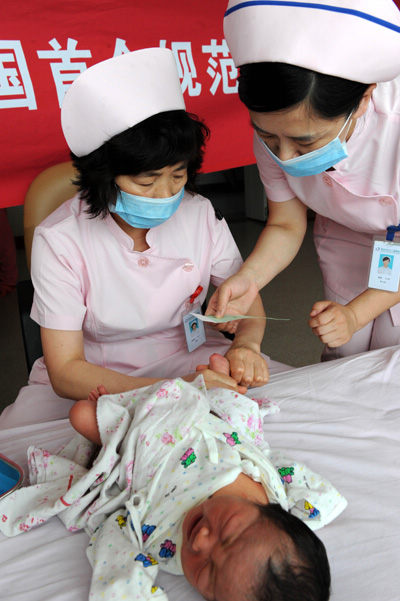|
 |
|
NEONATAL SCREENING: Nurses in Qingdao Women and Children's Hospital in Shandong Province take a blood sample of a newborn for a congenital disease test on June 8, 2012 (LI ZIHENG) |
As the Chinese Lunar New Year (February 10 this year) approaches, doctors and nurses in the Anhui Provincial Children's Hospital have one urgent wish: That the parents of an infant they just treated would come to the hospital to retrieve their daughter, nicknamed Yuanyuan—a name given to the baby by doctors.
When Yuanyuan was found abandoned at the hospital's entrance on December 15 last year, the then three-day-old was bundled in a quilt, with a note saying that she had been diagnosed with congenital esophageal atresia, a birth defect interrupting the passage between the esophagus and stomach.
Yuanyuan was weak, her lips blue from cold and oozing white foam, a nurse who was on duty told local Web portal Anhuinews.com.
"If not operated upon in time, she would have died," said Liu Guanghui, Director of the Neonatology Department of the hospital, who said that food was entering her windpipe and mixing with inhaled air, causing vomiting, bloating and pneumonia.
Doctors operated on Yuanyuan to repair the defect. Jin Danqun, a doctor in the hospital's Intensive Care Unit, said that the girl had recovered completely, and grew from 2.7 kg to 3.5 kg during her month in the hospital.
"Now that Yuanyuan has been cured, we wish her parents will take her home. Do not leave such a young child parentless," Jin said.
Growing defects
Each year, about 900,000 babies with congenital defects are born in China, accounting for 5.6 percent of all newborns, according to a report on the prevention and treatment of birth defects released by the Ministry of Health in September 2012.
Some of the most common birth defects in China in the past decade are congenital heart diseases, extra or webbed digits, cleft lip or palate, neural tube defects, hydrocephalus (water on the brain), club foot and microtia, according to the report.
Like Yuanyuan, many babies with birth defects, especially those born to poor families, are abandoned by their biological parents.
The report shows that perinatal period birth defect incidence in the country has been on the rise. The overall incidence rose from 107.79 per 10,000 live births in 2000 to 153.23 per 10,000 live births in 2011.
But the trend differs for specific types of defect, the report says. The incidence of some pernicious birth defects sensitive to intervention measures has gradually declined. For instance, the incidence of neural tube defects dropped from 27.4 per 10,000 live births in 1987, the most prevalent defect that year, to 4.5 per 10,000 live births in 2011, the eighth most prevalent. During the 2000-11 period, the incidence of neural tube defects went down by 62.4 percent in China's urban areas and 72.8 percent in rural areas.
In the same period, the incidence of congenital heart diseases increased sharply partly due to progress in diagnosis, the report says. In 2011, the incidence of congenital heart diseases was 3.56 times that of 2000.
The report also reveals that as infant mortality caused by infectious diseases has dropped, birth defects have risen to be the second largest cause of infant mortality in China, attributing to 19.1 percent of infant deaths.
There are a wide variety of congenital defects and they can be caused by different factors. "So far, at least 8,000-10,000 types of birth defects have been identified in China, 25 percent of which are inherited, 10 percent are caused by environmental factors and the causes of 65 percent remain unknown," Zheng Xiaoying, Director of Peking University's Institute of Population Research, told China Youth Daily.
|
